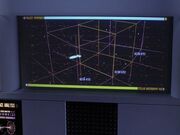Multiple sectors of the Alpha and Beta Quadrants
In stellar cartography a sector, also referred to as a star sector or space sector, is a large region of space, sometimes referred to as a quadrant. (TNG: "Conspiracy")
William T. Riker felt that the warp coil was perhaps one of the greatest advances in Humanity since the 22nd century, explaining that "before there was warp drive, Humans were confined to one sector of the galaxy." (TNG: "A Matter of Time")
Size and range

A map containing Sectors 41751, 41752, and 41753
Sectors are composed of an area and volume encompassing several light years.
When the USS Enterprise was probed while en route through an unfamiliar sector of space in 2269, the crew was able to determine the source as being from a planet in the Taurean system, a system located twenty light years away, at the extreme edge of their sector. (TAS: "The Lorelei Signal")
In preparation for Operation Lovely Angel, the USS Enterprise-D scanned all sectors located within three light years of the Oneamisu sector. (TNG: "Peak Performance")
A Template:ShipClass ship was capable of scanning a radius of ten light years at a time, which allowed the ship to effectively scan one sector per day. (TNG: "The Wounded")
While en route to the planet Barisa Prime in 2371, Captain Benjamin Sisko noted that the closest ship in that sector, the USS Ulysses, which was exploring the Helaspont Nebula, was located twenty hours away at maximum warp. (DS9: "The Adversary")
The territory occupied by the Swarm species covered "a huge area of space" and included "hundreds of sectors." For the USS Voyager to go around that region, it would have taken over fifteen months at maximum warp. (VOY: "The Swarm")
Voyager's use of the graviton catapult "hurtled" the ship across thirty sectors of space in less than an hour, a journey that would have otherwise taken three years to accomplish. (VOY: "The Voyager Conspiracy")
Composition
A map of Sector Z-6
Sectors typically contain several star systems.
Sector Z-6 encompasses both Federation and Romulan space, and during the 23rd century, included seven Earth Outpost Stations, the Romulan Neutral Zone, as well as Romulus and Romii. (TOS: "Balance of Terror")
The sector containing the Murasaki Effect contained at least four complete solar systems. (TOS: "The Galileo Seven")
The sector containing the planet Iconia contained three other systems whose inhabitants had several cultural similarities with the Iconians. (TNG: "Contagion")
The sector where the Enterprise-D intercepted the class 8 probe occupied by Ambassador K'Ehleyr was said to contain very little, yet included four colonies and nine outposts throughout. A nearby sector that was threatened by the Klingon sleeper ship IKS T'Ong contained thirteen Federation colonies. (TNG: "The Emissary")
When the shuttlecraft Cochrane achieved warp 10, it collected data describing "literally every cubic centimeter" of the sector they were in – an amount of information exceeding five billion gigaquads. (VOY: "Threshold")
Naming
Most sectors are numbered, and in some cases, named after an important star system in that sector. In Federation nomenclature, the Sol system and Earth are located in Sector 001. (TNG: "The Best of Both Worlds") Others are named after a key star system, such as the Mutara sector. (Star Trek II: The Wrath of Khan) In other cases, they are given a designation consisting of both a name and number, such as Rhomboid Dronegar sector 006. (TNG: "Samaritan Snare")
List of sectors
- See List of sectors
Background
Several production references, including the Star Trek Encyclopedia, expand a bit into the specifics defining a sector to include that it "is a volume of space approximately twenty light years across. A typical sector in Federation space will contain about six to ten star systems, although sectors toward the galactic core will often contain many more."
